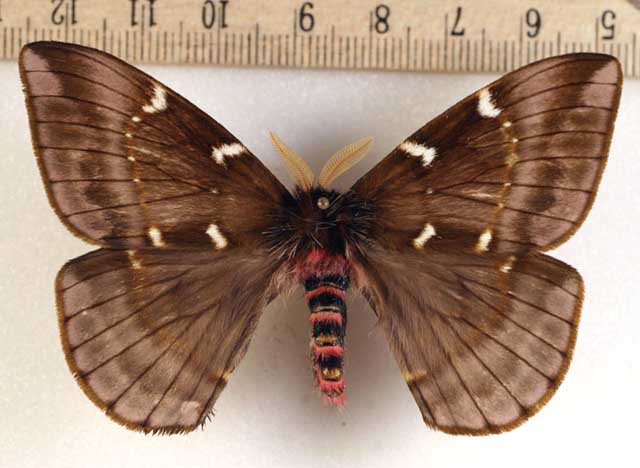Paradirphia valverdei
|
|
Updated as per Lemaire's Hemileucinae 2002, July 16, 2006
Updated as per Entomo Satsphingia Jahrgang 3 Heft 4 12.08.2010; September 13, 2014
|
Paradirphia valverdei
pah-ruh-DIRF-ee-uhMVAL-verd-eye
Lemaire & Wolfe, 1990

Paradirphia valverdei male, copyright protected,
courtesy of Kirby Wolfe.
TAXONOMY:
Superfamily: Bombycoidea, Latreille, 1802
Family: Saturniidae, Boisduval, [1837] 1834
Subfamily: Hemileucinae, Grote & Robinson, 1866
Tribe: Hemileucinae, Grote & Robinson, 1866
Genus: Paradirphia Michener, 1949
|
MIDI MUSIC
"Someone to Watch
Over Me"
copyright C. Odenkirk
MIDI CITY
ON.OFF
<bgsound src="watch.mid" LOOP=FOREVER>
|
DISTRIBUTION:
Paradirphia valverdei
(wingspan: males: 64-70mm; females: 84-88mm) flies at moderate elevations (1200-2000m) in
Oaxaca and Veracruz, Mexico; and in
Olancho, Honduras.

Paradirphia semirosea/anikae/valverdei???, Oaxaca, Mexico, courtesy of
Kelly Price
I do not know for sure if the above moth is Paradirphia semirosea or a slightly warn Paradirphia valverdei. Both species
fly in Oaxaca, Mexico. It could also be the more recently described P. anikae. Both anikae and semirosea show higher levels of contrast
than does valverdei, and the Kelly Price image does show a high contrast level.

Paradirphia valverdei male, Oaxaca, Mexico,
on my home computer only.
Lemaire indicates that Paradirphia semirosea from Oaxaca usually have yellow rings on the abdomen, but red rings from
other locations. Examination of the ventral surface might help.
Paradirphia valverdei does not have yellow discal spots on the ventral surfaces. There are also other Paradirphia from Oaxaca.
FLIGHT TIMES AND PREFERRED FOOD PLANTS:
This species is on the wing June - August.
Larvae feed on Prunus in captivity. Natural host(s) is
unknown.

Paradirphia valverdei male (Mexico),
courtesy of Dr. Manuel A.
Balcazar Lara

Paradirphia valverdei female, 88mm, Oaxaca, Mexico,
on my home computer only.
ECLOSION, SCENTING AND MATING:
Females extend a scent
gland from the tip of the abdomen, and the night-flying males pickup
and track the airbourne pheromone plume with their well-developed
antennae.
EGGS, LARVAE, COCOONS AND PUPAE:
Eggs are deposited in clusters
on hostplant foliage.
Paradirphia valverdei larvae are highly gregarious and have the
urticating spines typical of larvae from the Subfamily Hemileucinae.

Paradirphia valverdei larva, copyright protected,
courtesy of Kirby Wolfe.
Larval Food Plants
It is hoped that this
alphabetical listing followed by the common name of the foodplant will
prove useful. The list is not exhaustive. Experimenting with closely
related foodplants is worthwhile.
Use your browser "Back" button to return to the previous page.
Return to Paradirphia Genus
Return to Mexican and Central American Saturniidae Directory
Return to Main WLSS Index
The pronunciation of scientific names is
troublesome for many. The "suggestion" at the top of the page is
merely a suggestion. It is based on commonly
accepted English pronunciation of Greek names and/or some
fairly well accepted "rules" for latinized scientific names.
The suggested pronunciations, on this page and on other pages,
are primarily put forward to assist those who hear with internal
ears as they read.
There are many collectors from different countries whose
intonations and accents would be different.
Some of the early describers/namers chose genus
and species names indicating some character of the insect, but more
often, they simply chose names from Greek or Roman mythology or
history.Those species names which end in "ensis" indicate a
specimen locale, and those which end in "i", pronounced "eye", honour
a contempory friend/collector/etc.
I do not know the source of the genus
name "Paradirphia" chosen by Michener in 1849, but it
probably has to do with the similarity of these moths to those
in the genus Dirphia.
The species name "valverdei" is honourific for Valverde.

| 
Support this website and visit other insect sites by
clicking flashing butterfly links to left or right.
|

|
Use your browser "Back" button to return to the previous page.











